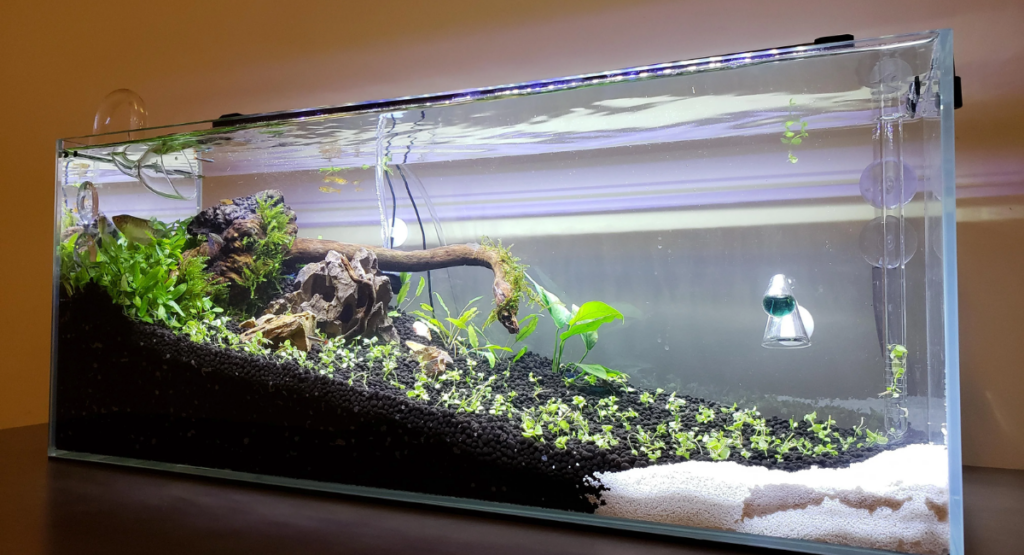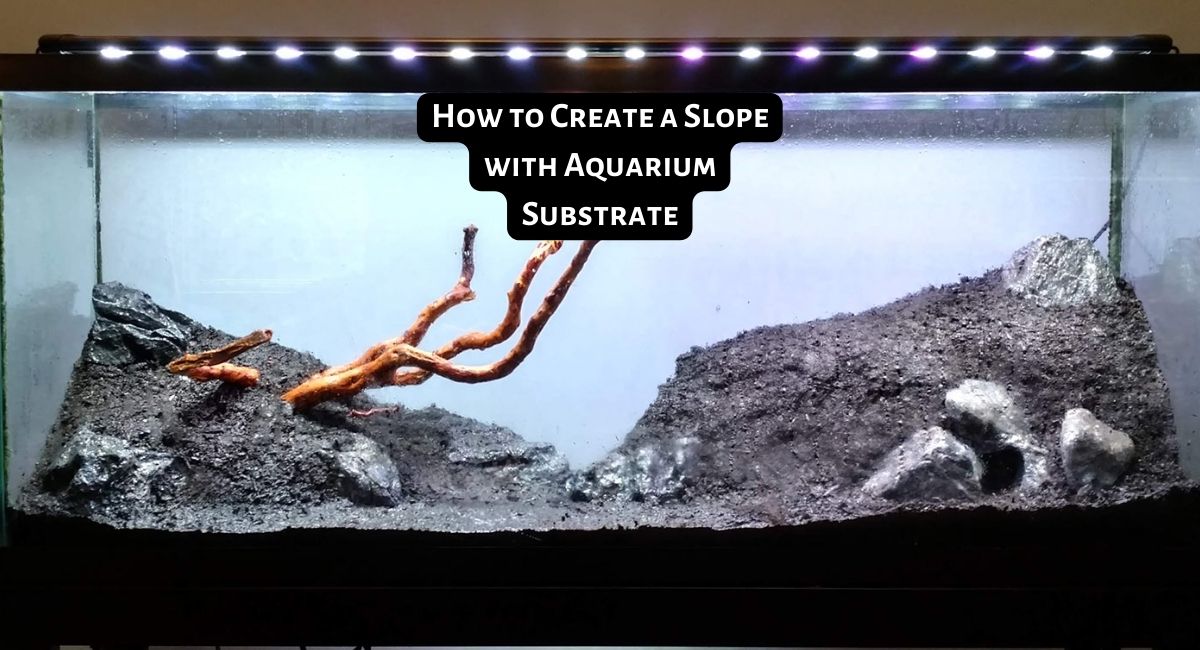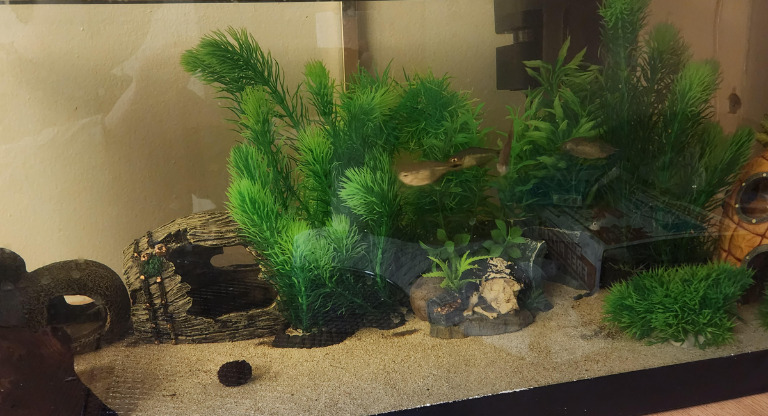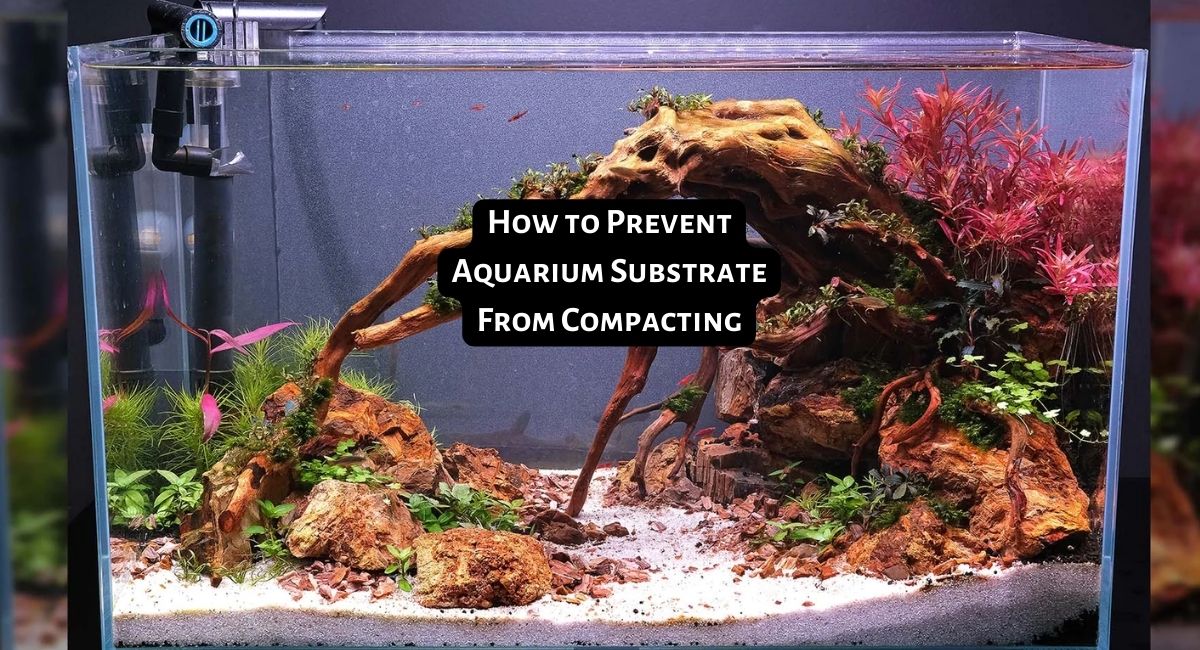Smartplantedaquarium.com participates in affiliate marketing programs. We may earn commissions on purchases made through our affiliate links. This doesn't affect our content or recommendations and we only recommend products we would put in our own tanks.
Designing an aquarium is an art form that combines aquatic beauty with a touch of nature’s aesthetics. One of the key elements in achieving a captivating aquatic environment is the proper arrangement of aquarium substrate. Among the various techniques available, creating a slope with aquarium substrate stands out as a way to add depth, dimension, and visual interest to your underwater world.
In this comprehensive guide, we will delve into the art of crafting slopes using aquarium substrate. From selecting the right materials to step-by-step implementation, we will cover everything you need to know to transform your aquarium into a mesmerizing aquatic masterpiece.
Whether you’re a beginner or an experienced aquarist looking to enhance your skills, this guide will provide valuable insights and practical tips to create a stunning sloped substrate in your aquarium.
Contents
- Key Takeaways
- Why Slope Your Substrate
- Selecting the Perfect Substrate for Sloping: Factors to Consider
- How to Create a Slope with Aquarium Substrate
- Advanced Techniques for Elevating Your Sloped Aquarium Substrate Design
- Maintenance Tips for Sustaining Substrate Slopes in Your Aquarium
- Conclusion
- Frequently Asked Questions
- 1. How do you elevate a substrate in an aquarium?
- 2. How do I ensure proper compaction when creating a slope?
- 3. Can I use multiple substrate types to create a slope?
- 4. How do I prevent erosion and shifting of the slope?
- 5. What plants are suitable for a sloped substrate?
- 6. Can I create multiple levels or terraces within the slope?
Key Takeaways
- Sloping aquarium substrate adds depth, dimension, and visual interest to your underwater world.
- Sloping the substrate replicates natural aquatic environments and creates a more engaging environment for aquatic species.
- A sloped substrate adds depth and dimension to your aquarium, making it visually captivating.
- Creating a slope with your substrate opens up possibilities for creative aquascaping.
- A sloped substrate benefits plant growth and root development by allowing for better light penetration and preventing sediment accumulation.
- A sloped substrate improves water circulation in the aquarium and can be used to hide equipment.
- When selecting substrate for sloping, consider particle size, substrate type, compatibility with plants, color, pH and water chemistry, ease of maintenance, budget, experience level, and compatibility with inhabitants.
- To create a slope with aquarium substrate, empty the tank, plan the slope, prepare the substrate, create a foundation, build the slope gradually, shape and level the slope, compact the substrate, add water and decorations, and cycle the aquarium.
- Advanced techniques for sloping include creating multi-layered slopes and terracing, incorporating substrate color gradients, and designing substrate paths and riverbed illusions.
- Maintain your sloped aquarium substrate by regularly cleaning and maintaining the substrate, properly feeding and caring for your aquatic inhabitants, monitoring water parameters, and addressing any issues or imbalances promptly.
Why Slope Your Substrate
When it comes to creating an aquarium that resembles a piece of nature’s beauty, the arrangement of aquarium substrate plays a pivotal role. One technique that can significantly elevate your aquarium’s visual appeal and ecological balance is sloping the substrate. But why should you consider this technique for your aquatic haven?
Mimicking Natural Environments: In the wild, aquatic landscapes are rarely flat; they feature undulating terrains, varying depths, and slopes that add a sense of depth and realism. By incorporating a sloped substrate in your aquarium, you can replicate the natural underwater landscapes that many aquatic species call home. This not only enhances the aesthetics but also creates a more engaging environment for your aquatic inhabitants.
Depth and Dimension: A sloped substrate introduces a sense of depth and dimension to your aquarium, making it visually captivating. The gradual increase in substrate height creates a natural transition from the foreground to the background, providing a visually appealing focal point. This depth perception can make your aquarium feel more spacious and dynamic.
Aquascaping Opportunities: Creating a slope with your substrate opens up endless possibilities for creative aquascaping. The varying substrate levels allow you to experiment with different plant placements, decorative elements, and architectural structures. This creative freedom empowers you to design a unique aquatic landscape that reflects your personal style.
Plant Growth and Root Development: Aquatic plants often benefit from a sloped substrate. As you elevate the substrate towards the rear of the aquarium, you create a tiered planting area. This arrangement allows for better light penetration, promoting healthier plant growth. Additionally, the sloped substrate helps prevent sediment accumulation around the roots, which can be detrimental to plant health.
Improved Water Circulation: A sloped substrate can contribute to better water circulation within the aquarium. The gentle slope guides water flow from the higher rear section to the lower front section, preventing stagnant areas and promoting even distribution of nutrients and oxygen throughout the tank.
Hiding Equipment: Sloping substrate can be strategically used to conceal equipment such as filters, heaters, and air pumps. By placing these elements behind the slope, you maintain a cleaner and more natural appearance in your aquarium, reducing visual distractions.
Selecting the Perfect Substrate for Sloping: Factors to Consider

Choosing the right substrate is a crucial step in creating a captivating sloped aquarium landscape. The substrate you select not only affects the visual appeal of your underwater world but also influences the health and well-being of your aquatic inhabitants. Here are key factors to consider when choosing the ideal substrate for your sloping project:
Particle Size: The particle size of the substrate plays a vital role in achieving a stable and visually pleasing slope. For sloping purposes, consider using a substrate with varying particle sizes. A mix of fine and coarse particles helps create a stable slope structure, preventing erosion and maintaining the desired incline.
Substrate Type: Various substrate materials are available, each with its own advantages and considerations. Common substrate types include aquarium gravel, sand, and specialized planted substrates. If you plan to have live plants in your aquarium, opt for a substrate specifically designed to support plant growth by providing essential nutrients.
Compatibility with Plants: If live plants are a central component of your aquarium design, choose a substrate that promotes healthy plant growth. Plant-specific substrates often contain nutrients that benefit root development and overall plant vitality. Research the substrate’s nutrient content and compatibility with your chosen plant species.
Color and Aesthetics: The color of the substrate contributes significantly to the overall visual impact of your aquarium. Consider the color scheme you’re aiming for and select a substrate that complements your design. Dark substrates can enhance the vibrancy of colorful fish and plants, while light substrates can create a clean and airy aesthetic.
pH and Water Chemistry: Certain substrates can influence the pH and water chemistry of your aquarium. If you’re keeping fish or plants that require specific water parameters, choose a substrate that aligns with those requirements. Some substrates may raise or lower the pH, so research their effects on water chemistry.
Ease of Maintenance: Consider how easy it will be to maintain the chosen substrate. Substrates that trap debris or require frequent cleaning can become cumbersome over time. Choose a substrate that is manageable and fits your maintenance routine.
Budget: Substrate costs can vary significantly based on the type and brand. Set a budget for your sloping project and choose a substrate that meets your aesthetic and functional needs within that budget.
Experience Level: Your experience level as an aquarist can influence your substrate choice. Some substrates may require more careful maintenance or adjustments, while others are more forgiving. Choose a substrate that aligns with your expertise and comfort level.
Compatibility with Inhabitants: Consider the needs and behaviors of your aquatic inhabitants. Some fish species, particularly bottom-dwellers, prefer certain types of substrates for burrowing or sifting through.
How to Create a Slope with Aquarium Substrate
A well-executed slope adds depth, dimension, and natural beauty to your aquarium, enhancing both its aesthetic appeal and the well-being of your aquatic inhabitants. In this step-by-step guide, we will walk you through the process of creating a captivating slope with aquarium substrate.
From preparation to implementation, you’ll learn the techniques and insights needed to achieve a stunning sloped design that captures the essence of underwater nature.
- Empty the aquarium: Begin by removing all the items from your aquarium, including any fish, plants, decorations, and water. Make sure the tank is completely empty so you can work on creating the slope.
- Plan your slope: Visualize where you want the slope to be in your aquarium. Consider the layout of your tank and where you want the highest point of the slope to be. Decide whether you want a gradual, gentle slope or a steeper, more dramatic one.
- Prepare the substrate: If you are using a new substrate, it’s important to wash it thoroughly before adding it to the tank. Take a cleaning container or bucket and place the substrate inside. Slowly pour water into the container and stir the substrate with your hands or a clean tool. Keep doing this until the water runs clear, indicating that all the dust and debris has been removed.
- Create a foundation: Begin by placing a layer of aquarium-safe substrate at the bottom of the tank. This layer should be evenly spread and about 1 inch thick. The purpose of this layer is to provide a stable base for your slope.
- Build the slope: Start adding the substrate gradually, starting from the bottom of the tank. Begin with a thin layer of substrate and gradually increase it as you move up. For a gradual slope, increase the layer thickness gradually. For a steeper slope, you may need to add more substrate at once. Use your hands or a clean tool to shape the slope as you go, gradually creating the desired incline.
- Shape and level the slope: Once you’ve built the slope, use your hands or a clean tool (such as a flat-ended stick) to shape and level the substrate. Smooth out any uneven areas and make sure the slope looks natural and visually pleasing. Take your time with this step to ensure that your slope is well-formed.
- Compact the substrate: Gently press down on the substrate to compact it slightly. This will help to prevent shifting and settling once you add water. Be careful not to press too firmly, as this could disturb the slope you’ve created.
- Add water and decorations: Slowly fill the tank with water, pouring the water onto a plate or using a plastic bag to prevent disturbing the slope. Pouring water directly onto the substrate may cause it to shift and ruin your slope. Once the tank is filled, you can add your decorations, plants, and other aquarium features as desired.
Remember to cycle your aquarium before adding fish or other aquatic creatures. Cycling ensures that the beneficial bacteria have established in your tank and are able to maintain a healthy and stable environment for your aquatic pets.
Advanced Techniques for Elevating Your Sloped Aquarium Substrate Design
Advancing your sloped aquarium substrate design involves incorporating intricate techniques that add depth, dimension, and artistic flair to your aquatic landscape. These techniques allow you to create multi-layered slopes, incorporate substrate color gradients, and design captivating paths and riverbed illusions. Here’s a detailed explanation of each advanced technique:
Multi-Layered Slopes and Terracing
- Visual Depth and Dimension: Multi-layered slopes introduce multiple levels of elevation within your substrate design. These distinct terraces provide a visually engaging and dynamic look that emulates natural landscapes with varying elevations.
- Gradual Step-Ups: To create multi-layered slopes, start by establishing the base layer as the foundation. Gradually build up the substrate in steps or terraces, each following the contour of the slope. As you ascend, you create the illusion of elevated landforms.
- Plant Selection and Arrangement: Strategically select plants for each terrace based on their height and growth habit. Taller plants should be positioned on higher terraces, while shorter ones inhabit lower levels. This arrangement adds complexity to your aquascape by simulating a natural progression of plant growth.
Incorporating Substrate Color Gradients
- Color Harmony and Transition: Substrate color gradients involve transitioning substrate colors across the slope to mimic natural environmental variations. This technique enhances the aesthetic appeal and realism of your aquarium.
- Selecting Substrate Colors: Choose substrate colors that smoothly blend or transition from one to another. For instance, you could start with dark substrate at the back of the aquarium and gradually shift to lighter hues towards the front.
- Layering and Blending: Begin by adding the darkest substrate color at the highest point of the slope. As you descend, layer in progressively lighter shades. Use compacting techniques while adding each layer to ensure a seamless transition between colors.
Designing Substrate Paths and Riverbed Illusions
- Creating Pathways: Incorporating substrate paths adds intrigue and a sense of exploration to your aquascape. These paths simulate walking trails through a natural landscape and guide the viewer’s focus.
- Substrate Selection: Opt for a substrate material or color that contrasts with the surrounding slope. This contrast delineates the path and makes it visually distinct from the rest of the substrate.
- Riverbed Illusions: Designing a riverbed illusion involves crafting the appearance of a flowing river within your slope. Use light-colored substrate to represent the river’s path and darker substrate to simulate the riverbanks.
- Enhance Realism with Decor: Introduce decorative elements such as rocks or driftwood along the path to heighten the riverbed illusion. These additions create a natural border for the simulated river, enhancing the illusion’s authenticity.
Maintenance Tips for Sustaining Substrate Slopes in Your Aquarium
To preserve the beauty and health of your carefully crafted sloped aquarium substrate, diligent maintenance is essential. Proper care ensures that your aquatic landscape remains visually stunning and provides a thriving environment for your aquatic inhabitants. Here’s a comprehensive explanation of each maintenance tip:
Regular Inspection: Conduct routine inspections to identify any changes in the slope’s structure or appearance. Look for signs of erosion, settling, or shifting, and address them promptly to prevent further degradation.
Gently Vacuuming: During regular maintenance sessions, use a gravel vacuum or siphon to remove debris, uneaten food, and waste from the substrate. Be cautious when vacuuming around plants, employing a gentle touch to avoid disturbing their roots or the substrate layers.
Pruning and Trimming: Regularly trim and prune your plants to prevent overcrowding and maintain the intended aesthetic. Overgrown plants can overshadow others and disrupt the balance of the slope’s design.
Compacting Touch-Ups: As part of your maintenance routine, perform gentle compacting touch-ups. Use a flat tool to press down any areas that may have become less compacted over time, ensuring the stability of the slope.
Preventive Water Changes: Implement regular water changes to maintain optimal water quality. During water changes, be cautious around the slope to avoid disturbing the substrate layers and the arrangement of plants and decorations.
Algae Control: Monitor the substrate for algae growth. Gently remove algae using a soft brush or sponge to prevent it from detracting from the beauty of the slope. Address any underlying factors that contribute to excessive algae growth.
Avoid Overfeeding: Overfeeding can lead to excess waste settling in the substrate. Feed your aquatic inhabitants in moderation to minimize waste accumulation and maintain water quality.
Watch for Plant Growth: Keep an eye on plant growth to prevent overgrowth that can disrupt the slope’s balance. Trim and replant as needed to maintain the desired appearance.
Maintain Water Parameters: Consistently monitor and maintain stable water parameters within the suitable range for your aquatic inhabitants and plants. Fluctuations can stress your aquarium’s ecosystem and affect the slope’s health.
Avoid Disturbances: When performing tasks such as moving decorations or equipment, be cautious not to disturb the substrate layers or displace plants. Minimize disruptions to maintain the slope’s integrity.
Plan Changes Carefully: If you intend to make adjustments to the slope’s design, plan the changes thoughtfully. Execute changes slowly and methodically to avoid causing disturbances that could affect the overall structure.
Document Changes: Maintain a record of any modifications made to the slope, including plant additions, removals, and alterations. This documentation enables you to track the progression of your aquascape and make informed decisions.
Conclusion
Creating a slope with aquarium substrate can be an easy task when done properly. It is important to take your time and plan out the slope carefully before beginning. Make sure you have all of the necessary materials, including measuring tools and aquatic gravel or sand, before starting.
Once you have everything in place, use either the dry method or wet method to create your desired grade within the aquarium. With patience and care, you can achieve a perfect gradient that will enhance the beauty of your tank even further.
Frequently Asked Questions
1. How do you elevate a substrate in an aquarium?
Creating an elevated substrate in an aquarium can be done by using a raised platform or ramp structure. These platforms should be built out of materials that are safe for the aquatic environment such as rock, plastic or glass. The slope of the ramp or platform should be gradual, and the height should vary based on how much elevation is desired. Once the structure is in place, aquarium-safe substrate such as sand, gravel or clay can be added to create a sloped surface within the tank. Additionally, plants and other decorations can also be used to provide additional depth to the aquarium and help enhance its overall aesthetic.
2. How do I ensure proper compaction when creating a slope?
Proper compaction is crucial to maintain the stability of your slope over time. To achieve this, gently press down each layer of substrate as you build the slope. Use flat tools or your hands to create an even and compact layer. Pay attention to potential air pockets that may form during the process, as these can lead to uneven settling. Regularly check and gently press down any areas that feel less compacted to ensure a solid foundation for your slope.
3. Can I use multiple substrate types to create a slope?
Yes, creating substrate blends by combining different types of substrates is a creative approach. Blending nutrient-rich soil with sand or gravel, for instance, allows you to provide essential nutrients for plant growth while achieving the desired visual aesthetics. Such blends can offer the benefits of both substrates and cater to specific plant requirements, creating a more diverse and balanced substrate environment.
4. How do I prevent erosion and shifting of the slope?
To prevent erosion and slope shifting, adopt a comprehensive strategy. Start by planting a variety of vegetation with robust root systems suited to the slope’s conditions. Construct terraces using materials like stone or wood to break up water flow, and utilize erosion control blankets made of materials like straw or coconut fiber. Implement proper drainage systems with gutters, downspouts, and ditches to divert water away from the slope. Avoid overwatering to prevent soil loosening, watering deeply but less frequently to maintain soil stability. These measures collectively help safeguard against erosion and shifting on slopes.
5. What plants are suitable for a sloped substrate?
Selecting appropriate plants for a sloped substrate is crucial for erosion prevention and landscape aesthetics. Opt for vegetation with sturdy root systems and adaptability to the slope’s specific conditions, including angle, sunlight exposure, soil type, and moisture levels. Plant a diverse mix of trees, shrubs, and groundcovers that can establish deep roots, anchoring the soil effectively. Native species often thrive on slopes as they are adapted to local conditions. It’s advisable to consult with a local nursery or horticulturist for plant recommendations tailored to your particular sloped area.
6. Can I create multiple levels or terraces within the slope?
Yes, creating multi-layered slopes with terraces adds complexity and visual interest to your aquarium. By gradually building up the substrate in steps or terraces, you simulate natural elevation changes seen in various landscapes. This technique allows you to diversify plant placement, as well as create distinct zones within your aquascape. Ensure that each terrace follows the natural contour of the slope for a harmonious and cohesive appearance.






